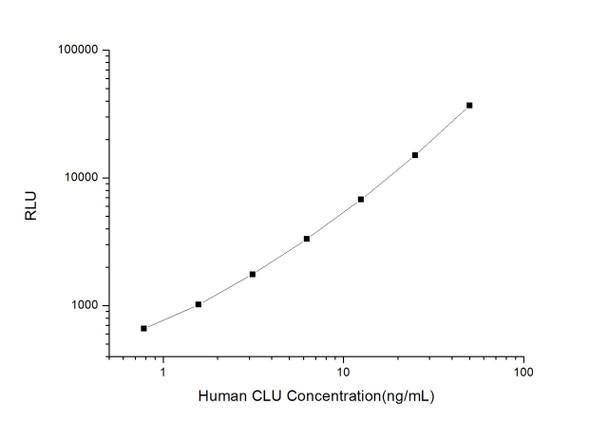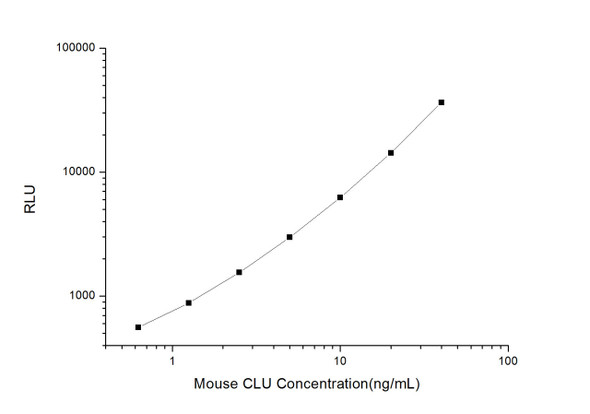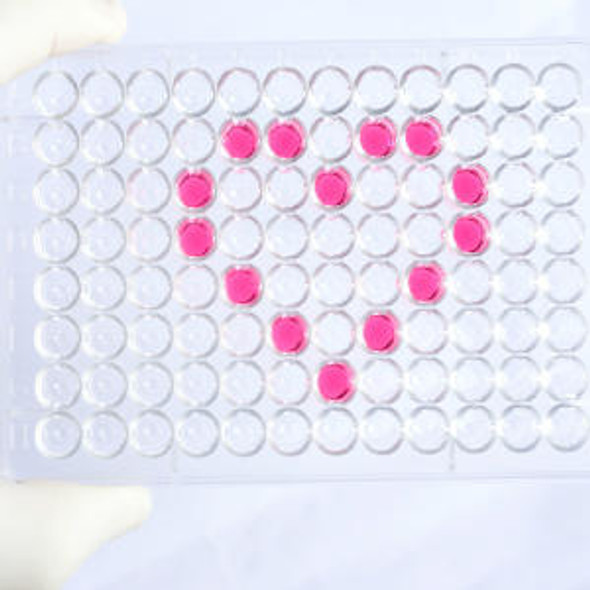Human Cell Death ELISA Kits
Human CLU (Clusterin) CLIA Kit (HUES00037)
- SKU:
- HUES00037
- Product Type:
- ELISA Kit
- ELISA Type:
- CLIA Kit
- Size:
- 96 Assays
- Sensitivity:
- 0.47ng/mL
- Range:
- 0.78-50ng/mL
- ELISA Type:
- Sandwich
- Synonyms:
- APO-J, APOJ, CLI, KUB1, NA1/NA2, SGP2, SP-40, TRPM2
- Reactivity:
- Human
- Sample Type:
- Serum, plasma and other biological fluids
- Research Area:
- Cell Death
Description
| Assay type: | Sandwich |
| Format: | 96T |
| Assay time: | 4.5h |
| Reactivity: | Human |
| Detection method: | Chemiluminescence |
| Detection range: | 0.78-50 ng/mL |
| Sensitivity: | 0.47 ng/mL |
| Sample volume: | 100µL |
| Sample type: | Serum, plasma and other biological fluids |
| Repeatability: | CV < 15% |
| Specificity: | This kit recognizes Human CLU in samples. No significant cross-reactivity or interference between Human CLU and analogues was observed. |
This kit uses Sandwich-CLIA as the method. The micro CLIA plate provided in this kit has been pre-coated with an antibody specific to Human CLU. Standards or samples are added to the appropriate micro CLIA plate wells and combined with the specific antibody. Then a biotinylated detection antibody specific for Human CLU and Avidin-Horseradish Peroxidase (HRP) conjugate are added to each micro plate well successively and incubated. Free components are washed away. The substrate solution is added to each well. Only those wells that contain Human CLU, biotinylated detection antibody and Avidin-HRP conjugate will appear fluorescence. The Relative light unit (RLU) value is measured spectrophotometrically by the Chemiluminescence immunoassay analyzer. The RLU value is positively associated with the concentration of Human CLU. The concentration of Human CLU in the samples can be calculated by comparing the RLU of the samples to the standard curve.
| UniProt Protein Function: | CLU: Isoform 1 functions as extracellular chaperone that prevents aggregation of nonnative proteins. Prevents stress- induced aggregation of blood plasma proteins. Inhibits formation of amyloid fibrils by APP, APOC2, B2M, CALCA, CSN3, SNCA and aggregation-prone LYZ variants (in vitro). Does not require ATP. Maintains partially unfolded proteins in a state appropriate for subsequent refolding by other chaperones, such as HSPA8/HSC70. Does not refold proteins by itself. Binding to cell surface receptors triggers internalization of the chaperone-client complex and subsequent lysosomal or proteasomal degradation. Secreted isoform 1 protects cells against apoptosis and against cytolysis by complement. Intracellular isoforms interact with ubiquitin and SCF (SKP1-CUL1-F-box protein) E3 ubiquitin-protein ligase complexes and promote the ubiquitination and subsequent proteasomal degradation of target proteins. Promotes proteasomal degradation of COMMD1 and IKBKB. Modulates NF-kappa-B transcriptional activity. Nuclear isoforms promote apoptosis. Mitochondrial isoforms suppress BAX-dependent release of cytochrome c into the cytoplasm and inhibit apoptosis. Plays a role in the regulation of cell proliferation. Belongs to the clusterin family. 5 isoforms of the human protein are produced by alternative splicing. |
| UniProt Protein Details: | Protein type:Secreted; Apoptosis; Mitochondrial; Secreted, signal peptide Chromosomal Location of Human Ortholog: 8p21-p12 Cellular Component: extracellular matrix; Golgi apparatus; extracellular space; mitochondrion; endoplasmic reticulum; perinuclear region of cytoplasm; mitochondrial membrane; cytoplasm; extracellular region; nucleus; cytosol Molecular Function:protein binding; chaperone binding; ubiquitin protein ligase binding; ATPase activity; misfolded protein binding Biological Process: platelet activation; release of cytochrome c from mitochondria; response to misfolded protein; positive regulation of nitric oxide biosynthetic process; protein stabilization; positive regulation of apoptosis; response to virus; cell morphogenesis; microglial cell activation; positive regulation of tumor necrosis factor production; negative regulation of protein homooligomerization; activation of NF-kappaB transcription factor; complement activation; reverse cholesterol transport; platelet degranulation; myelin maintenance in the central nervous system; positive regulation of proteasomal ubiquitin-dependent protein catabolic process; protein import; innate immune response; lipid metabolic process; blood coagulation; chaperone-mediated protein complex assembly; complement activation, classical pathway |
| NCBI Summary: | The protein encoded by this gene is a secreted chaperone that can under some stress conditions also be found in the cell cytosol. It has been suggested to be involved in several basic biological events such as cell death, tumor progression, and neurodegenerative disorders. Alternate splicing results in both coding and non-coding variants. [provided by RefSeq, May 2011] |
| UniProt Code: | P10909 |
| NCBI GenInfo Identifier: | 116533 |
| NCBI Gene ID: | 1191 |
| NCBI Accession: | P10909. 1 |
| UniProt Secondary Accession: | P10909,P11380, P11381, Q2TU75, Q5HYC1, Q7Z5B9, B2R9Q1 B3KSE6, |
| UniProt Related Accession: | P10909,AAB25217 |
| Molecular Weight: | Calculated: 32kDa/48kDa/52kDa/53kDa/57kDaObserved: 40kDa |
| NCBI Full Name: | Clusterin |
| NCBI Synonym Full Names: | clusterin |
| NCBI Official Symbol: | CLU |
| NCBI Official Synonym Symbols: | CLI; AAG4; APOJ; CLU1; CLU2; KUB1; SGP2; APO-J; SGP-2; SP-40; TRPM2; TRPM-2; NA1/NA2 |
| NCBI Protein Information: | clusterin; apolipoprotein J; ku70-binding protein 1; sulfated glycoprotein 2; aging-associated protein 4; complement lysis inhibitor; complement cytolysis inhibitor; complement-associated protein SP-40,40; testosterone-repressed prostate message 2 |
| UniProt Protein Name: | Clusterin |
| UniProt Synonym Protein Names: | Aging-associated gene 4 protein; Apolipoprotein J; Apo-J; Complement cytolysis inhibitor; CLI; Complement-associated protein SP-40,40; Ku70-binding protein 1; NA1/NA2; Testosterone-repressed prostate message 2; TRPM-2 |
| Protein Family: | Clusterin |
| UniProt Gene Name: | CLU |
| UniProt Entry Name: | CLUS_HUMAN |
As the RLU values of the standard curve may vary according to the conditions of the actual assay performance (e. g. operator, pipetting technique, washing technique or temperature effects), the operator should establish a standard curve for each test. Typical standard curve and data is provided below for reference only.
| Concentration (ng/mL) | RLU | Average | Corrected |
| 50 | 36519 37443 | 36981 | 36959 |
| 25 | 14936 15194 | 15065 | 15043 |
| 12.5 | 6919 6681 | 6800 | 6778 |
| 6.25 | 3187 3495 | 3341 | 3319 |
| 3.13 | 1893 1665 | 1779 | 1757 |
| 1.56 | 1084 998 | 1041 | 1019 |
| 0.78 | 674 690 | 682 | 660 |
| 0 | 21 23 | 22 | -- |
Precision
Intra-assay Precision (Precision within an assay): 3 samples with low, mid range and high level Human CLU were tested 20 times on one plate, respectively.
Inter-assay Precision (Precision between assays): 3 samples with low, mid range and high level Human CLU were tested on 3 different plates, 20 replicates in each plate.
| Intra-assay Precision | Inter-assay Precision | |||||
| Sample | 1 | 2 | 3 | 1 | 2 | 3 |
| n | 20 | 20 | 20 | 20 | 20 | 20 |
| Mean (ng/mL) | 2.68 | 7.54 | 20.12 | 2.57 | 7.38 | 21.21 |
| Standard deviation | 0.24 | 0.64 | 1.96 | 0.22 | 0.81 | 1.98 |
| C V (%) | 8.96 | 8.49 | 9.74 | 8.56 | 10.98 | 9.34 |
Recovery
The recovery of Human CLU spiked at three different levels in samples throughout the range of the assay was evaluated in various matrices.
| Sample Type | Range (%) | Average Recovery (%) |
| Serum (n=5) | 93-106 | 100 |
| EDTA plasma (n=5) | 95-110 | 101 |
| Cell culture media (n=5) | 99-116 | 107 |
Linearity
Samples were spiked with high concentrations of Human CLU and diluted with Reference Standard & Sample Diluent to produce samples with values within the range of the assay.
| Serum (n=5) | EDTA plasma (n=5) | Cell culture media (n=5) | ||
| 1:2 | Range (%) | 100-118 | 92-104 | 94-105 |
| Average (%) | 107 | 98 | 99 | |
| 1:4 | Range (%) | 97-110 | 93-108 | 86-99 |
| Average (%) | 103 | 99 | 91 | |
| 1:8 | Range (%) | 89-103 | 98-114 | 99-114 |
| Average (%) | 94 | 104 | 105 | |
| 1:16 | Range (%) | 92-103 | 100-119 | 100-116 |
| Average (%) | 98 | 108 | 108 |
An unopened kit can be stored at 4°C for 1 month. If the kit is not used within 1 month, store the items separately according to the following conditions once the kit is received.
| Item | Specifications | Storage |
| Micro CLIA Plate(Dismountable) | 8 wells ×12 strips | -20°C, 6 months |
| Reference Standard | 2 vials | |
| Concentrated Biotinylated Detection Ab (100×) | 1 vial, 120 µL | |
| Concentrated HRP Conjugate (100×) | 1 vial, 120 µL | -20°C(shading light), 6 months |
| Reference Standard & Sample Diluent | 1 vial, 20 mL | 4°C, 6 months |
| Biotinylated Detection Ab Diluent | 1 vial, 14 mL | |
| HRP Conjugate Diluent | 1 vial, 14 mL | |
| Concentrated Wash Buffer (25×) | 1 vial, 30 mL | |
| Substrate Reagent A | 1 vial, 5 mL | 4°C (shading light) |
| Substrate Reagent B | 1 vial, 5 mL | 4°C (shading light) |
| Plate Sealer | 5 pieces | |
| Product Description | 1 copy | |
| Certificate of Analysis | 1 copy |
- Set standard, test sample and control (zero) wells on the pre-coated plate and record theirpositions. It is recommended to measure each standard and sample in duplicate. Note: addall solutions to the bottom of the plate wells while avoiding contact with the well walls. Ensuresolutions do not foam when adding to the wells.
- Aliquot 100µl of standard solutions into the standard wells.
- Add 100µl of Sample / Standard dilution buffer into the control (zero) well.
- Add 100µl of properly diluted sample (serum, plasma, tissue homogenates and otherbiological fluids. ) into test sample wells.
- Cover the plate with the sealer provided in the kit and incubate for 90 min at 37°C.
- Aspirate the liquid from each well, do not wash. Immediately add 100µL of BiotinylatedDetection Ab working solution to each well. Cover the plate with a plate seal and gently mix. Incubate for 1 hour at 37°C.
- Aspirate or decant the solution from the plate and add 350µL of wash buffer to each welland incubate for 1-2 minutes at room temperature. Aspirate the solution from each well andclap the plate on absorbent filter paper to dry. Repeat this process 3 times. Note: a microplatewasher can be used in this step and other wash steps.
- Add 100µL of HRP Conjugate working solution to each well. Cover with a plate seal andincubate for 30 min at 37°C.
- Aspirate or decant the solution from each well. Repeat the wash process for five times asconducted in step 7.
- Add 100µL of Substrate mixture solution to each well. Cover with a new plate seal andincubate for no more than 5 min at 37°C. Protect the plate from light.
- Determine the RLU value of each well immediately.






